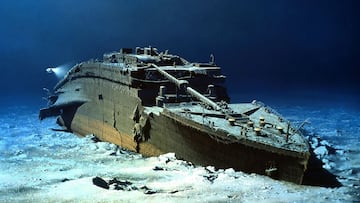Why human remains were never found at the Titanic wreckage
The Titanic plunged to the bottom of the Atlantic Ocean in 1912 but the wreckage wasn’t located until 1985. No trace of human remains have been found.

Over a century since the world was left in a state of shock by the the sinking of the Titanic, there are still plenty of mysteries and theories about the course of events, with endless questions still left answered.
New discoveries are made about the tragedy year after year, with progress towards answering those questions hampered by the difficult location of the wreckage on the floor of the Atlantic Ocean. There is still plenty of investigation to be done, with limited exploration of the sunken vessel possible due to the complexity and hazards of diving to such extreme depths.
The moment the Titanic’s wreckage was discovered just after 1 a.m. on Sept. 1, 1985
— Massimo (@Rainmaker1973) June 16, 2024
[📹 National Geographic]pic.twitter.com/Ip9cddpjMw
You might also enjoy
Where is the wreckage of the Titanic?
The hull of the Titanic is approximately 3,800 metres deep and relatively close to Newfoundland and Labrador off the coast of Canada. With the passing of time, the ship’s remains have deteriorated, as you might expect, and it is believed that it will eventually dissolve almost completely due to the corrosive effect of salt water and termites on its materials. However, thanks to numerous investigative expeditions to the area, we do know that there is still a huge number of objects under water, many of which are the remains of the victims’ personal belongings.
Titanic 1st class menu vs 3rd class menu from April 14, 1912, the day before the Titanic sank. pic.twitter.com/RBDbfqfm2I
— Fascinating (@fasc1nate) April 3, 2024
What objects have been found near the Titanic?
Bottles of wine, ceramics, shoes, suitcases are among the items that can be seen strewn across the ocean floor, reminders of lives that were cut short by the icy Atlantic waves. More than 5,000 artifacts have been salvaged from the site during the past 39 years.
But, crucially, plenty is still missing: human remains. Some 1,160 people went down with the Titanic. but no bodies have ever been found. There are multiple theories as to why, although experts have been unable to completely solve the mystery once and for all.
An original deck chair from Titanic, recovered from the surface by the Mackay-Bennett, the first of four ships chartered by the White Star Line.#TitanicBelfast pic.twitter.com/uCIjPKeS3N
— Titanic Belfast (@TitanicBelfast) May 26, 2024
The effects of sea water
One thing that cannot be overlooked is that it took more than 70 years for the wreckage of the ship to even be located. When investigations began, everything had already long been exposed to seawater. However, it hasn’t been ruled out that there could still be bodies on board inside the deepest parts of the vessel, such as the engine room, which the water has had less of an effect on.
The last known picture of the famous Titanic, April 11, 1912. pic.twitter.com/ZloKN8zSe0
— Historic Hub (@HistoricHub) July 31, 2022
What is clear, though, is that almost all of the missing bodies have been dissolving and will continue to do so until their eventual disappearance. Not only because of the salt water but also because of ocean animals, termites and bacteria in the area, which feed on human tissues such as skin.
Related stories

Remembering the five aboard the Titan submersible

The cost of the Titan search
According to marine archaeologist James Delgado, “even human teeth” can dissolve at that depth. Perhaps, then, the “mystery” of the missing bodies from the Titanic tragedy isn’t as cryptic as we thought after all.
This week it emerged that RMS Titanic Inc, the Georgia-based company that owns the salvage rights to the Titanic, plans to visit the wreckage site in July using remotely operated vehicles. Meanwhile, Larry Connor, a real estate billionaire from Ohio and founding partner of Triton Submarines, has stated that he plans a voyage to the shipwreck in a two-person submersible in 2026.
Complete your personal details to comment